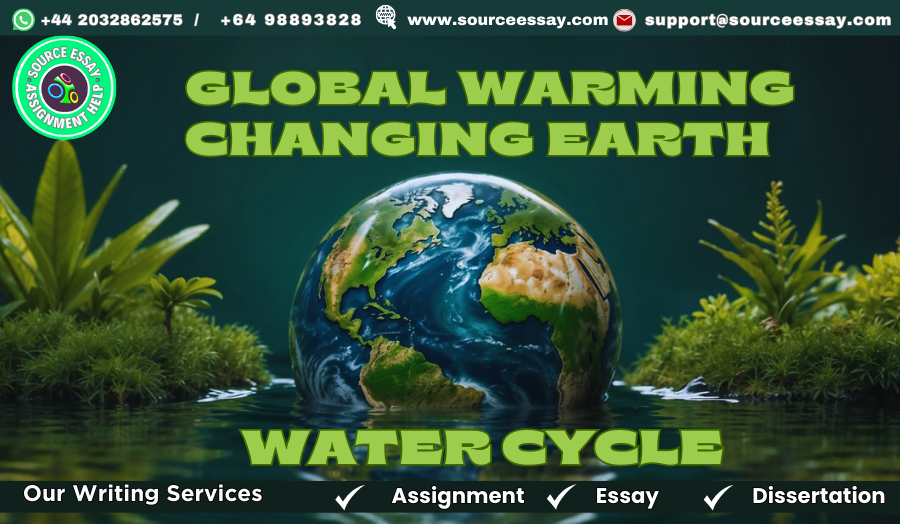Earth’s water cycle
As we are aware, water is something without which we cannot survive. Water is always on the move. When rain falls today, it may have been part of a distant ocean yesterday. Before encountering you today, it was in a stream or high mountain top as snow. Water is everywhere.
In the atmosphere, on land, in the ocean, and underground, water changes location from one place to another. In that case, we call it the water cycle. Let’s explore how changing climate has impacted the water cycle.
Impacting the water cycle
Let’s understand how climate change is impacting the water cycle. What does it mean to ‘speed up’ due to warming global temperatures? Increased evaporation globally becomes a concerning situation. If evaporation is quite high, the precipitation on average also increases. We have seen the impact of increasing climate warming all over the globe.
You must be asking whether evaporation is happening faster and the precipitation rate is also high. It is a concern because the distribution of precipitation around the globe is not uniform. In certain areas, precipitation can be heavier than the normal expected amount, while other areas may experience droughts.
Various climate models
Now taking back examples from various climate models created by great scientists that predict that coastal regions may receive more water compared to the middle areas of continents, and the continents gradually start to become drier. Additionally, the models highlight more evaporation and rainfall over oceans, but this is not expected to occur over land.
Climate change brought on by humans.
One thing that often comes to mind when discussing climate change and rising temperatures on Earth is marine life. Because of climate change brought on by humans, marine species that are native to tropical regions of the planet are currently straining the boundaries of their physiological ability to adapt to rising temperatures.
Marine species
Marine species that are now at their thermal physiological limitations in their resource run the risk of being displaced, according to recent research conducted by experts from the Australian National University.
Sea levels were much lower
Moving forward, let’s emphasize understanding and comprehending the worldwide sea level rise, which is related to climate change. As of taking the data from 2020, we see that sea levels are around 0.10 to 0.20 meters (approximately 0.3 to 0.7 feet). The reason we highlight this particular Notion is that centuries ago, sea levels were much lower compared to the contemporary period.
In the 24th century, sea level was expected to rise more than 1.1 meters, which is equivalent to 3.6 feet. This rise is correlated with greenhouse gas emissions, which is a continuous process at different levels.
Glaciers are melting down
The more mesmerizing fact is how climate change or global warming operates. To see sea levels rising, first of all, you have to understand that glaciers are melting down, and the water from these glaciers flows into rivers, eventually adding to the ocean through the water cycle. If we analyze data from the last 100 years, mountain glaciers, ice sheets, and Greenland ice are all decreasing in trend.(Schlesinger & Jasechko, 2014)
What do we mean by that? These glaciers are dramatically getting smaller. Therefore, it means that ocean and sea levels are going to be higher, as glaciers are melting. Melted ice is already part of the ocean, and minor impact has been seen on the rise of sea level.
Global warming
Second process, which is an environmental phenomenon, will underscore how ocean water and temperature are related. First, let’s consider what happens when water is warm. This occurs due to the impact of global warming, which increases the overall temperature. As a result, ice in polar regions melts, contributing to rising sea levels.
Orbiting our atmosphere.
During your childhood days, you must have read about the heat-trapping gasses, which became a phenomenon on planet Earth.
Since 1955, more than 90% of SSC (space solar cells),GREENHOUSE GASSES, have been orbiting our atmosphere. This is one of the reasons our oceans are getting hotter, and climate warming has become a dramatically concerning situation. Now, it is also contributing to ocean water expansion and rising sea levels, leading to increased flooding. This situation is the talk of the town. Let’s now understand how sensitive this situation is for marine sustainability.
Proportional to water temperature
In the consequences, warmer waters lead to the death of coral reefs. Numerous coral animals have also seen their end due to coral bleaching. The process is directly proportional to water temperature rising. The coral and other marine life are completely trapped in a situation where they are unable to grow due to the presence of carbon dioxide and heat in the atmosphere. The increased acidity can be felt in the sea level water.
Dissertation Writing help UK, write my dissertation Leeds, Dissertation assignment help Sheffield
REFERENCE
Schlesinger, W. H., & Jasechko, S. (2014). Transpiration in the global water cycle. Agricultural and Forest Meteorology, 189–190, 115–117. https://doi.org/10.1016/j.agrformet.2014.01.011
Morris, C. E., Sands, D. C., Vinatzer, B. A., Glaux, C., Guilbaud, C., Buffière, A., Yan, S., Dominguez, H., & Thompson, B. M. (2008). The life history of the plant pathogen Pseudomonas syringae is linked to the water cycle. The ISME Journal, 2(3), 321–334. https://doi.org/10.1038/ismej.2007.113

